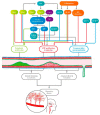Pathological Circulating Factors in Moyamoya Disease
- PMID: 33567654
- PMCID: PMC7915927
- DOI: 10.3390/ijms22041696
Pathological Circulating Factors in Moyamoya Disease
Abstract
Moyamoya disease (MMD) is a cerebrovascular disease that presents with vascular stenosis and a hazy network of collateral formations in angiography. However, the detailed pathogenic pathway remains unknown. Studies have indicated that in addition to variations in the of genetic factor RNF213, unusual circulating angiogenetic factors observed in patients with MMD may play a critical role in producing "Moyamoya vessels". Circulating angiogenetic factors, such as growth factors, vascular progenitor cells, cytokines, inflammatory factors, and other circulating proteins, could promote intimal hyperplasia in vessels and excessive collateral formation with defect structures through endothelial hyperplasia, smooth muscle migration, and atypical neovascularization. This study summarizes the hypothesized pathophysiology of how these circulating factors affect MMD and the interactive modulation between them.
Keywords: Moyamoya disease; RNF213; cerebrovascular disease; circulating factor; collateral formations; growth factors.
Conflict of interest statement
The authors declare no conflict of interest.
Figures

References
Publication types
MeSH terms
Substances
Grants and funding
LinkOut - more resources
Full Text Sources
Other Literature Sources

